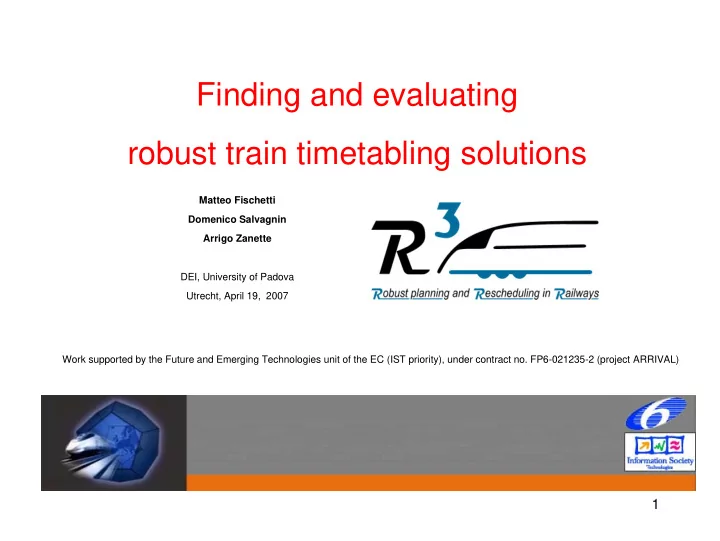

Finding and evaluating robust train timetabling solutions Matteo Fischetti Domenico Salvagnin Arrigo Zanette DEI, University of Padova Utrecht, April 19, 2007 Work supported by the Future and Emerging Technologies unit of the EC (IST priority), under contract no. FP6-021235-2 (project ARRIVAL) 1
Problem Definition single one-way line • aperiodic daily timetable to be designed • Minimize the timetable cost computed as follows… • 2
Ideal timetable Shift Actual timetable Ideal Departure Instant Station 1 stop Station 2 Stretch Station 3 stop Station 4 3
An event-scheduling MIP model Variables: Arrival and departure times (event times) …………. t i • Binary variables modeling event precedences ……… x ij • Constraints: d ij Minimum travel times • Safety constraints: • buffer times, no overtaking outside stations, etc. • t i − t j ≥ d ij − Mx ij Typical constraints of the type: • Objectives: • Minimize the cost of the schedule • Robustness (whatever it means) 4
Timetable robustness … … is not concerned with major disruptions • … is not intended to cope with heavy truck breaks or alike • � to be handled by REAL TIME CONTROL SYSTEMS • … is a way to control delay propagation • … has to favor delay compensation without heavy actions from the • traffic control center � no overtaking allowed to prevent delay propagation • � no train cancellation • � train precedences unchanged w.r.t. to the planned timetable • 5
6 Non-robust and robust timetables
Our approach Take a feasible timetable -> near-optimal solution of the “nominal” • timetable problem Fix a maximum price of robustness � the cost of the robust solution • cannot exceed by more than XX% the optimal cost of the nominal problem • Fix all train precedences (binary var.s x ij in the MIP model) • Relax the integrality on the event-time var.s t i (the only unknowns) Enforce robustness in the resulting LP by using alternative techniques • Evaluate the achieved robustness through a common validation • model • Compare the results 7
Pursuing robustness in the LP/MIP context • Stochastic Programming – Take first-stage decisions – Pay for restoring feasibility afterwards (second-stage recource var.s) – Applied successfully by the Kroon’s group to periodic timetabling – Very flexible but computationally heavy in scenario-based approaches • Robustness à la Bertsimas-Sim – Kind of worst-case analysis of robustness – Limits the moves of the adversary (just a few coefficients can change in each constraint) – Feasibility deterministic (if adversary behaves as expected) or with high probability (otherwise) – Very simple model – Unfortunaltely, of no use in the timetable context (infeasible or very inefficient solutions) Light Robustness • – “Light” version of Bertsimas-Sim using slack variables for “too conservative” constr.s – Linear or quadratic objective function (minimize slack var.s) Very well suited for timetabling � talk in the afternoon… – 8
Stochastic programming model • Two-stage model with recourse var.s (unabsorbed delay) Nominal constraint Recourse Disturbance • Deterministic model through scenario expansion • Objective function: minimize the average unabsorbed delay � big LP model to be solved (though each scenario actually introduces just a • few new var.s and constr.s) 9
Scenario Generation • Delay model: – Random cumulative train delay – Scaled by time band factors – Distributed across lines with section factors 10
Validation model x, ˜ (˜ t ) • Simulation tool used to evaluate the actual robustness of a given timetable Uses information on the line to generate a delay scenario for each run • • For each run, solve an LP model to absorbe as much delay as possible $ t x ij := ˜ x ij Fixed precedences � _ – i $ t i Continuous event-time var.s only � – = actual times in the delayed schedule t i ≥ ˜ t i Cannot anticipate with respect to the input solution to evaluate � – min P i ( t i − ˜ Minimize sum of delays (event-time shifts) � t i ) – • Gather statistical information 11
Test bed • Real world instances from RFI – PD-BO: 17 stations, ~35 trains – BZ-VR: 27 stations, ~130 trains – Mu-VR: 48 stations, ~50 trains – Br-BO: 48 stations, ~70 trains • For each instance, 5 almost-optimal (non- robust) timetables computed by DEIS 12
Validation results
Computing times
Restoring integrality on the timetable var.s
Importance of the quadratic LR function
19 Computing times (updated)
20 Thanks
Recommend
More recommend